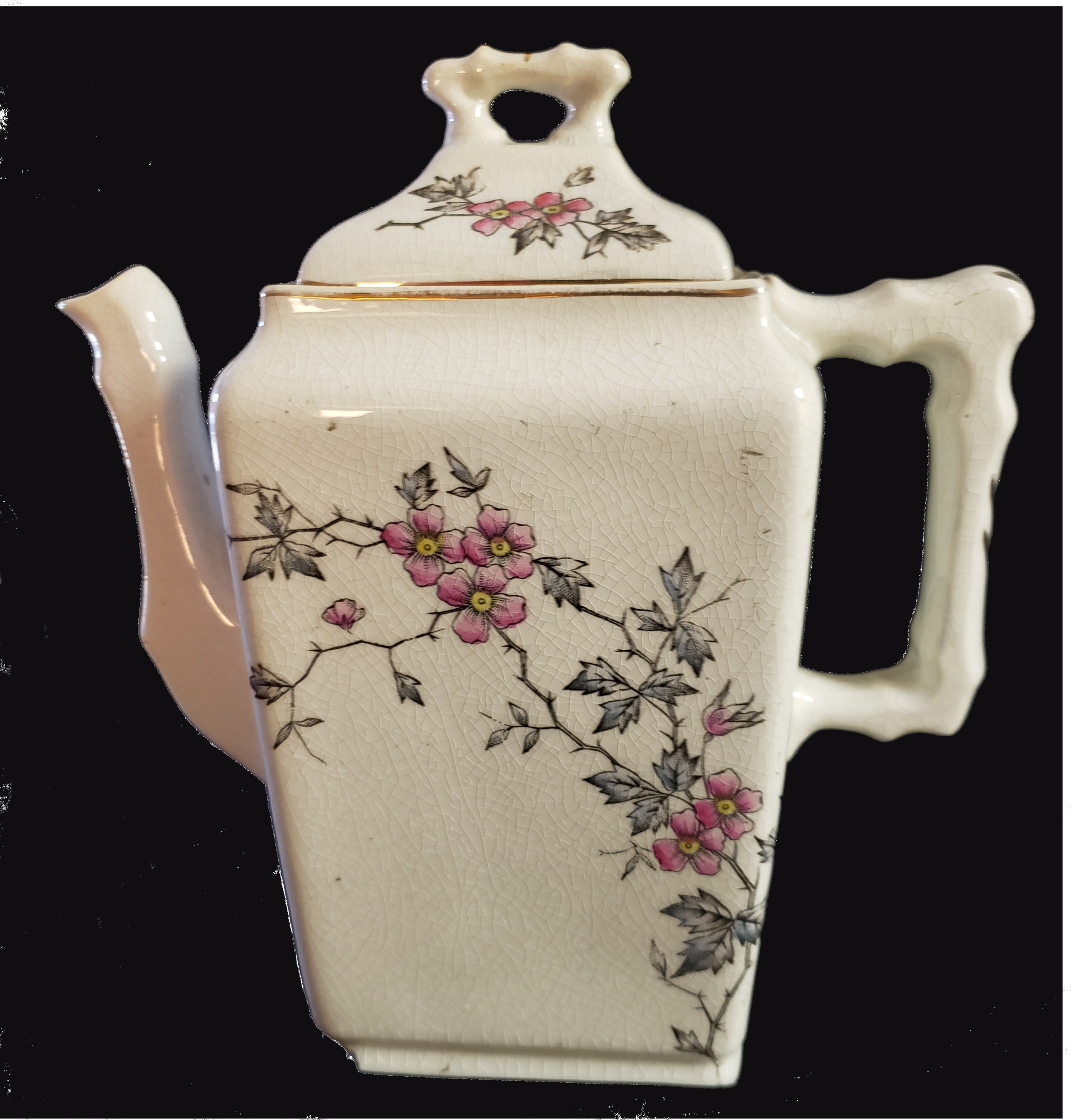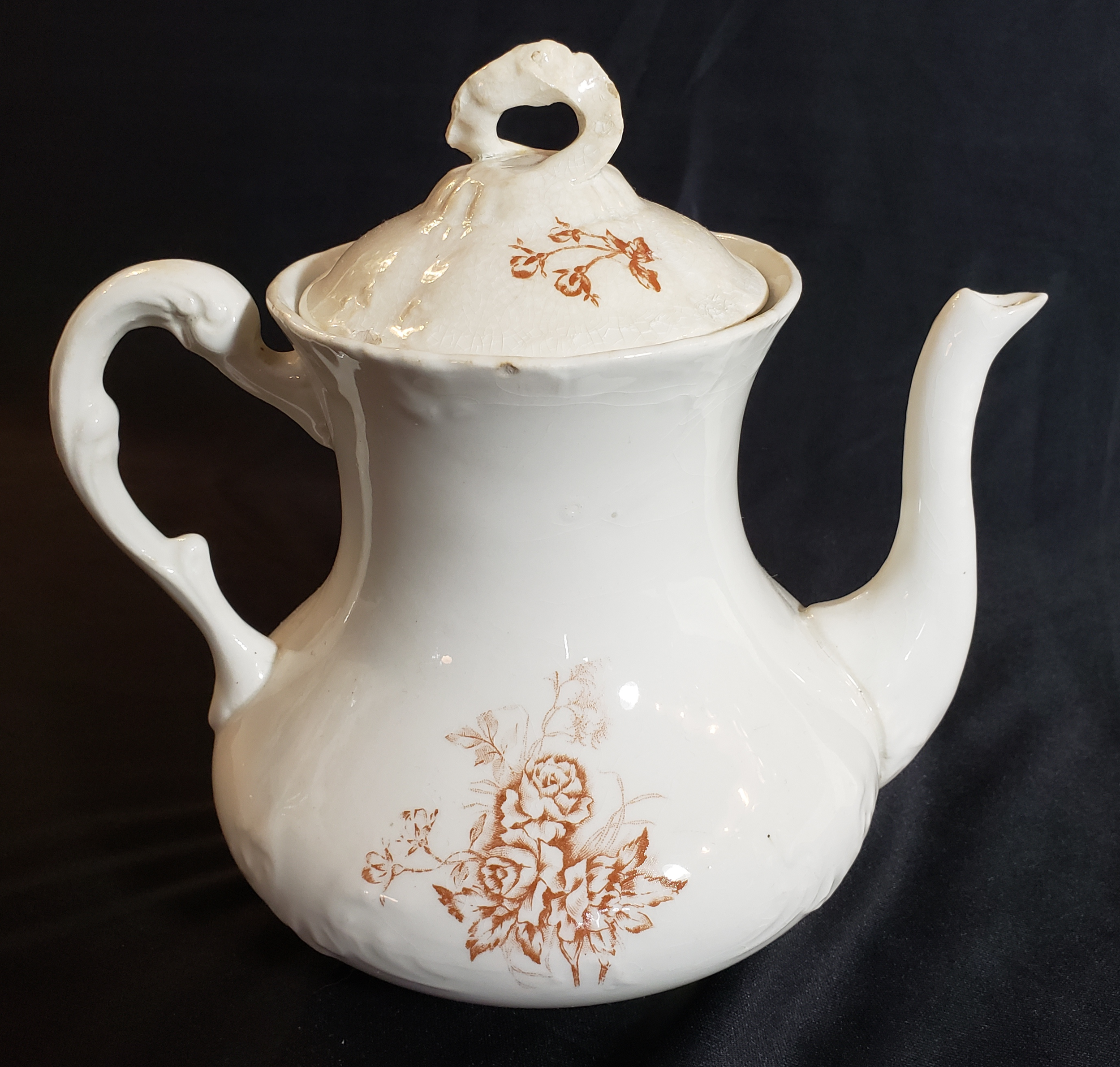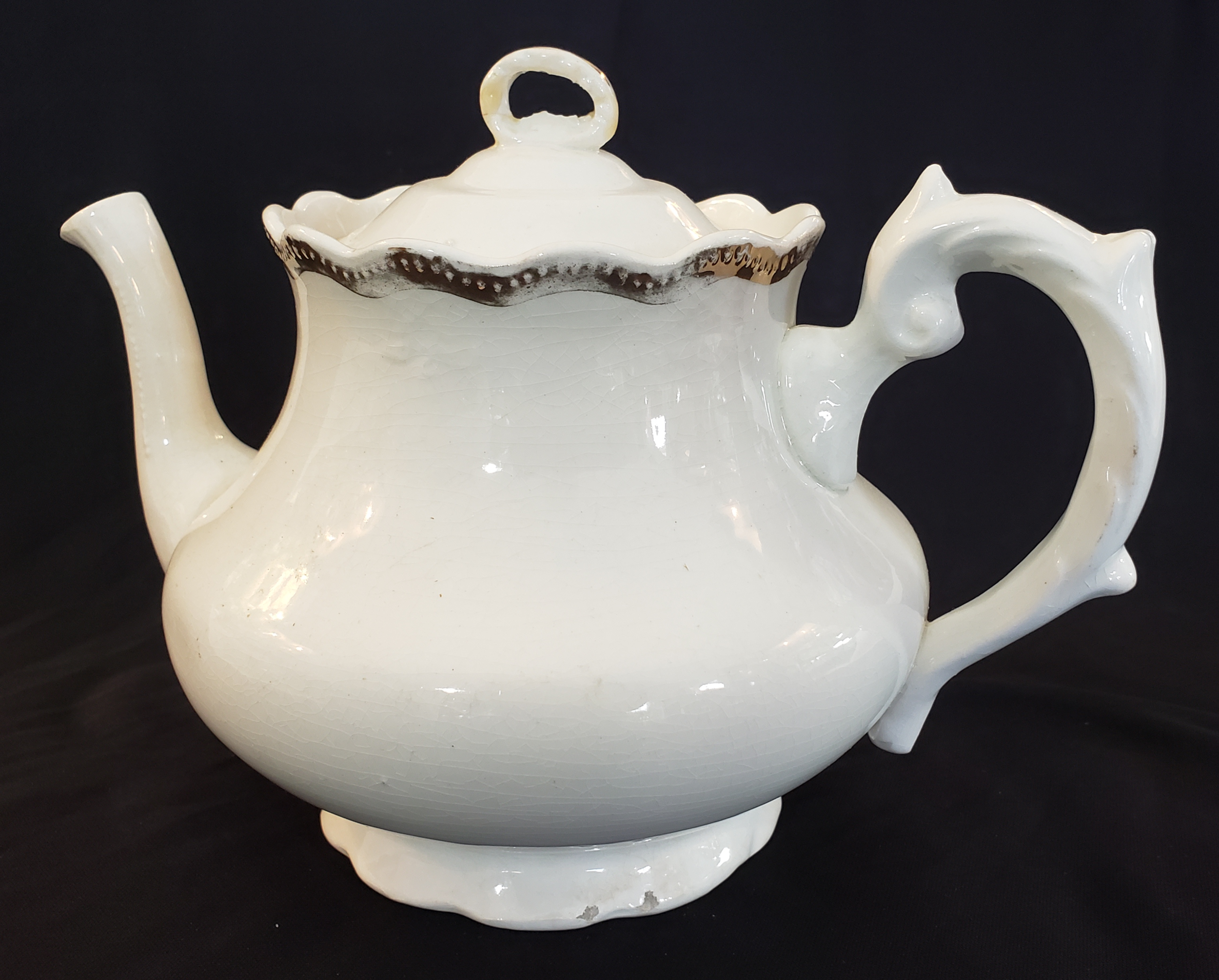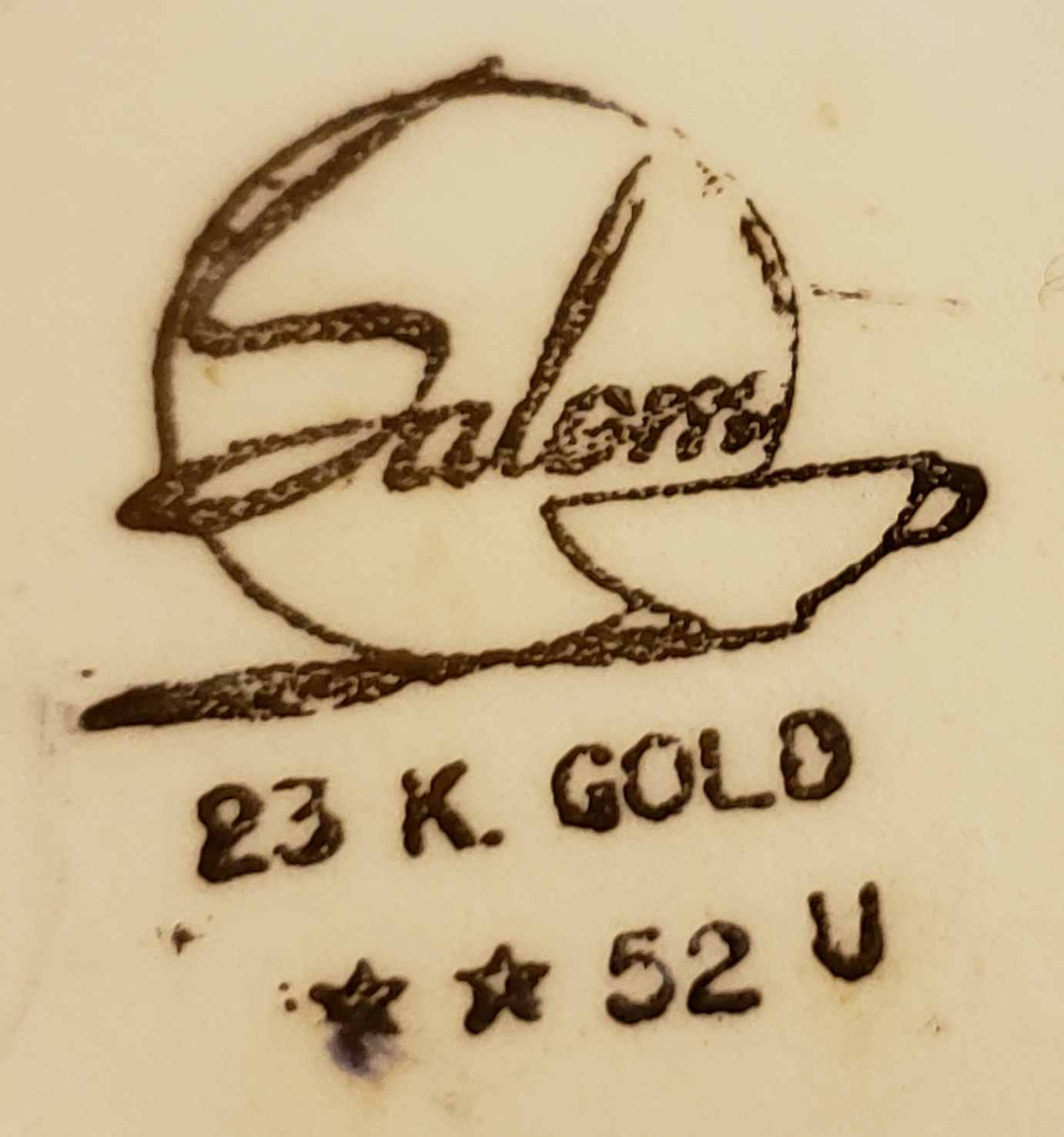Gallery ~ 2
Sebring Brothers and Company Pottery
TITLE:
MAKER: Sebring Brothers & Company
DATE: 1887-1900
COLLECTION: Museum of Ceramics/Ohio History Connection H191
The Sebring Brothers pottery was formed in 1887 by five (some sources list six) brothers, George E, Oliver, Ellsworth H, Frank A, Joseph, and two sisters along with George Ashbaugh and Sampson Turnbull. The original pottery was located in East Liverpool. In 1898 they purchased 2,000 acres in the adjacent Mahoning County and in 1900 moved the pottery to the community now bearing their name. (Gates, 2009).
Tea Trivia:
When the Han Dynasty Emperor Jing Di was discovered, archaeologists found tea leaves in his burial chamber of 141 BC. So, tea has been around for a long time, essentially proving that the Chinese have been drinking tea or using it for medicinal purposes for over two millennia. (Chamberlain, 2019).
TITLE: Child size teapot
MAKER: Sebring Brothers and Company Pottery
DATE: 1890-1905
COLLECTION: William and Donna Gray
By 1903, the Sebring Brothers Pottery consisted of four plants: the Oliver China Works, the Sebring Pottery Company, the French China Works, and the China Works. The company had a workforce of approximately 1200 men and were the “largest manufacturers of pottery in the United States.” The pottery comprised 24 ware kilns and 24 decorating kilns. (Genealogical, 1903).
Tea Trivia:
The oldest Camellia sinensis tea plant is thought to be in China and it is estimated to be around 3,200 years old. (Chamberlain, 2019).
TITLE: Tea Leaf
MAKER: Sebring Brothers and Company Pottery
DATE: 1887-1898
COLLECTION: William and Donna Gray
One of our Tea Leaf examples. The Sebring Brothers Pottery only manufactured ware with the Tea Leaf motif at their East Liverpool potteries. The motif was discontinued in 1898 when they founded and built their new pottery in what would become Sebring, Ohio.
The Tea Leaf motif was popular on 19th century pottery in the United States. The Tea Leaf motif consists of a copper and gold “lustre” band and a sprig. As the motif became popular many variations were later developed. There is a Tea Leaf International Club that keeps a Handbook/catalog of the variations, the potteries and makers. (Upchurch, 1995).
TITLE:
MAKER: Sebring Brothers and Company Pottery
DATE: 1890-1905
COLLECTION: William and Donna Gray
George Eugene Sebring was not only a potter but a visionary of town development. In 1899 the Sebring brothers laid out the community of what would become Sebring, Ohio in Mahoning county. The community would support the Sebring potteries.
In 1912, after purchasing some land in central Florida, that he enjoyed on a fishing trip, George laid out a circular pattern for a community that would become Sebring, Florida. The circular design of the town center has earned Sebring Florida the name “City on the Circle.” (George, 2020).
TITLE: Cable
MAKER: Sebring Brothers and Company Pottery
DATE: 1887-1898
COLLECTION: William and Donna Gray
There are many examples of the Cable shape in the exhibit from differing potteries. This beautifully decorated teapot, with a transfer design on each side, was made in the late 19th century in the Sebring Brothers, East Liverpool plant.
Cartwright Brothers Pottery Company
TITLE: Whiteware
MAKER: Cartwright Brothers Pottery Company
DATE: 1887-1896
COLLECTION: Museum of Ceramics/Ohio History Connection H336
In 1887, the Cartwright Brothers Company discontinued Rockingham and yellowware in favor of semi-granite and cream-colored ware. An example is seen here. The Cartwright Brothers were early potters in East Liverpool. William Cartwright and Holland Manley purchased an existing pottery, the Webster Stoneware pottery, in 1864. They would make extensive changes to bring production on line after the Civil War. In 1872, when Samuel Cartwright joined William as a partner in the pottery, the name of the pottery changed from Manley and Cartwright to Manley, Cartwright and Company, In 1880 when Holland Manley retired the company was incorporated as the Cartwright Brothers Pottery Company. (Gates, 2009).
TITLE: Glendora
MAKER: Cartwright Brothers Pottery Company
DATE: 1918
COLLECTION: William and Donna Gray
An advertisement for the Cartwright Bros. Co., in 1918, stated: “When you’re in East Liverpool don’t fail to call and see what we have to offer you for 1918. Our new lines of plain shape dinner ware and attractive specialties will be a hit for your department.”
TITLE: Tea Leaf
MAKER: Cartwright Brothers Pottery Company
DATE: 1887-1900
COLLECTION: William and Donna Gray
An ornate rendition of the Tea Leaf motif. This teapot exhibits the lustre edge line and the spray interwoven with additional foliage.
The Chicago Tribune, in 1978 stated that, “Tea Leaf china, a white ironstone decorated with a sprightly copper sprig” was one of the most popular items on the table of “American ladies” in the mid-19th century, approximately 20 American potteries, many in the East Liverpool pottery district, were producing their variation on the Tea Leaf motif. (Magazine, 2018).
Salem China Company
TITLE: Gold Teapot
MAKER: Salem Pottery
DATE: second quarter 1952
COLLECTION: Museum of Ceramics/Ohio History Connection
The Salem China Company was formed in a partnership by Patrick and John McNicol, Daniel and Cornelius Cronin, and William and E. J. Smith in 1898. Production began in 1899. In 1918, the company was purchased by F. A. Sebring, and continued until it ceased manufacturing in 1967. It remained in business as a sales and service company.
By the 1930s, the pottery was firing 25,000 pieces per day and at one time employed over 500 people.
From the 1930s through the 1950s, ware was dated with numbers and stars on the back. The number indicated the year of production and the stars the quarter of the year. For example, the teapot pictured would have been produced during the second quarter (April, May or June) of 1952.
In the 1930s and 1940s, Viktor Schreckengost designed many distinctive shapes for the Salem China Company including Tricorne, Biscayne and Free Form. (Gonzalez, 2020; Firestone, 1992).
Mountford and Company
TITLE:
MAKER: Mountford and Company
DATE: 1891-1897
COLLECTION: William and Donna Gray
Mountford and Company, like many of the early East Liverpool potteries, saw several partnerships and name changes before stabilizing. In 1891, John Rowe, who had been a partner since 1882, left the company known as Rowe and Mountford “following an argument that resulted in blows.” Mountford and Company was sold to George Murphy in 1897. (Gates, 2009).
Taylor, Lee and Smith Company
Tea Trivia:
Unlike other teas, Oolong tea can be steeped multiple times. Each time it releases a different layer of flavor. (Steeping, 2021).
TITLE:
MAKER: Taylor, Lee & Smith
DATE: 1900-1901
COLLECTION: William and Donna Gray
Taylor, Lee and Smith Company was the predecessor of the Taylor, Smith and Taylor Company.
In 1899, it was proposed that an eight kiln factory be built on the south side of Chester, a new community across the Ohio River from East Liverpool. Several pottery companies, including the Knowles, Taylor and Knowles Company, had relocated to Chester. The company began production in 1900 but no ware was shipped until early 1901. In September of 1901, Joseph G. Lee, withdrew from the company bringing an end to the Taylor, Lee and Smith Company and The Taylor, Smith and Taylor Company was organized and continued until 1981. (Gonzalez, 2017).
Dresden Pottery Company
TITLE:
MAKER: Dresden Pottery Company
DATE: 1925-1927
COLLECTION: William and Donna Gray
The Dresden Pottery Company was a short-lived partnership of Harry McNicol, T. A. and Patrick McNicol, William H. Vodrey and A. P. McPherson. These potters came together after the end of the Potter’s Cooperative Company. The company survived for only two years.(Gates, 2009).
TITLE: Rose Du Bery
MAKER: Dresden Pottery Company
DATE: 1925-1927
COLLECTION: William and Donna Gray
George Morley and Son
TITLE: Majolica
MAKER: George Morley and Son
DATE: 1884-1891
COLLECTION: Museum of Ceramics/Ohio History Connection H 1123._001
“Majolica was made originally by 14th Century potters and was popularized in the mid-15th Century. It takes its name from the Spanish island of Majorca, from which it was exported to Italy during the Italian Renaissance.
It soon made its way across Europe and eventually to America, where it made its debut at the Philadelphia Centennial Exhibition in 1876.
The process of making majolica includes applying a tin (lead, on early pieces) enamel to a fired piece of earthenware, forming a white, opaque, porous surface on which a design is painted.
The completed design is then coated with a transparent glaze and the piece is fired again.” (Heins, 2018).
George Morley was born in 1828 in Staffordshire, England, emigrating to the United States in 1849. After several endeavors he moved to East Liverpool in 1852. In 1878, he established the Morley and Company Pottery. In 1884, he was joined by his son(s) and they formed the George Morley and Son(s) Company in Wellsville, Ohio. Morley retired from the business in 1889 and was elected Mayor of East Liverpool in 1891. The business declared bankruptcy the same year. At the time of his death in November 1896, Morley was serving as a justice of the peace. (Morley, 2018, Without, 1896).
TITLE:
MAKER: George Morley and Son
DATE: 1884-1891
COLLECTION: William and Donna Gray
The George Morley and Son pottery in East Liverpool, was established in an existing pottery works 1n 1884. The pottery was called the “Lincoln Pottery,” possibly for Morley’s son Lincoln who was his partner.
TITLE:
MAKER: George Morley and Son
DATE: 1884-1891
COLLECTION: William and Donna Gray
Tea Trivia:
Darjeeling tea is more expensive than other teas because it can only be found and grown in a 70-square mile area at the foot of the Himalayas in West Bengal, India. Because of its rarity it is referred to by many as the “Champagne of teas.” (Goodwin, 2020).



































